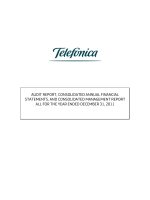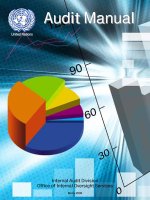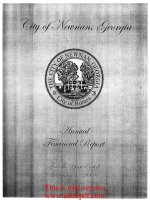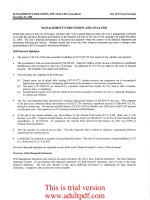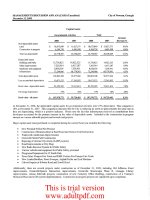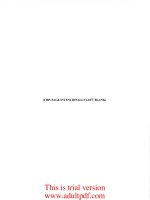State Agricultural Society Financial Audit For the Year Ended October 31, 1998 April 1999 Financial Audit Division Office of the Legislative Auditor State of Minnesota doc
Bạn đang xem bản rút gọn của tài liệu. Xem và tải ngay bản đầy đủ của tài liệu tại đây (803.25 KB, 10 trang )
State Agricultural Society
Financial Audit
For the Year Ended October 31, 1998
April 1999
Financial Audit Division
Office of the Legislative Auditor
State of Minnesota
99-22
Centennial Office Building, Saint Paul, MN 55155 651/296-4708
SUMMARY
State of Minnesota
Office of the Legislative Auditor
1st Floor Centennial Building
658 Cedar Street • St. Paul, MN 55155
(651)296-1727 • FAX (651)296-4712
TDD Relay: 1-800-627-3529
email:
URL:
State Agricultural Society
Financial Audit
For the Year Ended October 31, 1998
Public Release Date: April 15, 1999 No. 99-22
Agency Background
The State Agricultural Society was legally organized as a self-governing, public corporation in
1860. The Society operates under Minn. Stat. Chapter 37. The Minnesota State Agricultural
Society Board of Managers operates the annual state fair exposition and maintains the state
fairgrounds. The 10-member board is comprised of one representative from each of the Society's
nine regional districts and a president. Mr. Jerry Hammer serves as the executive vice president
of the Society.
Financial Highlights
The State Agricultural Society is financially self-sufficient. The society reported net income of
$1,987,740 for the year ended October 31, 1998, and $3,038,160 for the year ended October 31,
1997. The Society generated $22,618,708 in revenues during fiscal year 1998, including both
fair-time and non-fair event revenues. The Society's primary sources of revenue are fair-time
ticket sales and commercial space licenses. Significant expense classifications include activities
and support, plant maintenance, plant operations, administrative, and depreciation charges. The
Society had total assets of $26,028,051 as of October 31, 1998.
Audit Objectives and Conclusions
The audit objectives were to:
• issue an audit opinion on the Society's financial stateme nts as of October 31, 1998,
• obtain an understanding of the Society's internal control structure, and
• test the Society's compliance with significant finance-related legal provisions.
We issued an unqualified opinion, dated February 19, 1999, on the State Agricultural Society’s
financial statements for the year ended October 31, 1998. The Society’s annual report, which
includes its audited financial statements, is available from the Society’s offices.
We found that the Society’s board of managers did not approve a rate decrease for one of the
Society’s attractions, as required by the Society’s governing rules. In addition, the Society did
not have current signed contracts on file for certain of its vendors.
The Society agreed with our recommendations and are taking actions to resolve the issues.
STATE OF MINNESOTA
OFFICE OF THE LEGISLATIVE AUDITOR
JAMES R. NOBLES, LEGISLATIVE AUDITOR
Representative Dan McElroy, Chair
Legislative Audit Commission
Members of the Legislative Audit Commission
Mr. Vern Prokosch, President
Board of Managers
State Agricultural Society
Mr. Jerry Hammer, Executive Vice President
State Agricultural Society
Members of the State Agricultural Society
We have audited the State Agricultural Society for the year ended October 31, 1998. The
primary objective of our audit was to issue an opinion of the financial statements of the Society
for the year then ended. The State Agricultural Society Annual Report for the year ended
October 31, 1998, includes our opinion thereon dated February 19, 1999.
We conducted our audit in accordance with generally accepted auditing standards and
Government Auditing Standards, issued by the Comptroller General of the United States. As part
of obtaining reasonable assurance about whether the Society's financial statements are free from
material misstatement, we performed tests of the Society's compliance with certain provisions of
laws, regulations, contracts, and grants. We also obtained an understanding of the Society's
internal control structure. Our conclusions on compliance and internal control are included within
this report as the Report on Compliance and Internal Control over Financial Reporting Based on
an Audit of Financial Statements Performed in Accordance with Government Auditing
Standards.
This report is intended for the information of the Legislative Audit Commission and the
management of the State Agricultural Society. This restriction is not intended to limit the
distribution of this report, which was released as a public document on April 15, 1999.
James R. Nobles Claudia J. Gudvangen, CPA
Legislative Auditor Deputy Legislative Auditor
End of Fieldwork: February 19, 1999
Report Signed On: April 13, 1999
1ST FLOOR SOUTH, CENTENNIAL BUILDING 658 CEDAR STREET ST. PAUL, MN 55155
TELEPHONE 651/296-4708 TDD RELAY 651/297-5353 FAX 651/296-4712 WEB SITE
State Agricultural Society
Table of Contents
Page
Report on Compliance and Internal Control over Financial Reporting 1
Current Findings and Recommendations 3
Status of Prior Audit Issues 5
State Agricultural Society Response 6
Audit Participation
The following members of the Office of the Legislative Auditor prepared this report:
Claudia Gudvangen, CPA Deputy Legislative Auditor
Jeanine Leifeld, CPA Audit Manager
Susan Kachelmeyer, CPA Auditor-in-Charge
Mike Willis Staff Auditor
Terry Hansen Staff Auditor
Exit Conference
We discussed the results of the audit at an exit conference with the following staff of the State
Agricultural Society on April 2, 1999:
Jerry Hammer Executive Vice President
Marshall Jacobson Finance Director
1
STATE OF MINNESOTA
OFFICE OF THE LEGISLATIVE AUDITOR
JAMES R. NOBLES, LEGISLATIVE AUDITOR
Report on Compliance and Internal Control over Financial Reporting
Based on an Audit of Financial Statements
Performed in Accordance with Government Auditing Standards
Mr. Vern Prokosch, President
Board of Managers
State Agricultural Society
Mr. Jerry Hammer, Executive Vice President
State Agricultural Society
Members of the State Agricultural Society
We have audited the financial statements of the State Agricultural Society, as of and for the year
ended October 31, 1998, and have issued our report thereon dated February 19, 1999. We
conducted our audit in accordance with generally accepted auditing standards and the standards
applicable to financial audits contained in Government Auditing Standards, issued by the
Comptroller General of the United States.
Compliance
As part of obtaining reasonable assurance about whether the State Agricultural Society's
financial statements are free of material misstatement, we performed tests of its compliance
with certain provisions of laws, regulations, contracts, and grants, noncompliance with which
could have a direct and material effect on the determination of financial statement amounts.
However, providing an opinion on compliance with those provisions was not an objective of our
audit and, accordingly, we do not express such an opinion. The results of our tests disclosed one
instance of noncompliance that is required to be reported under Government Auditing Standards
and which is described as Finding 1 in the accompanying section entitled Current Findings and
Recommendations.
Internal Control over Financial Reporting
In planning and performing our audit, we considered the State Agricultural Society’s internal
control over financial reporting in order to determine our auditing procedures for the purpose of
expressing our opinion on the financial statements and not to provide assurance on the internal
control over financial reporting. However, we noted one matter involving the internal control
over financial reporting and its operation that we consider to be a reportable condition.
1ST FLOOR SOUTH, CENTENNIAL BUILDING 658 CEDAR STREET ST. PAUL, MN 55155
TELEPHONE 651/296-4708 TDD RELAY 651/297-5353 FAX 651/296-4712 WEB SITE
2
Mr. Vern Prokosch, President
Board of Managers
Mr. Jerry Hammer, Executive Vice President
Page 2
Reportable conditions involve matters coming to our attention relating to significant deficiencies
in the design or operation of the internal control over financial reporting that, in our judgment,
could adversely affect the State Agricultural Society’s ability to record, process, summarize, and
report financial data consistent with the assertions of management in the financial statements. We
describe the reportable condition as Finding 2 in the accompanying section entitled Current
Findings and Recommendations.
A material weakness is a condition in which the design or operation of one or more of the internal
control components does not reduce to a relatively low level the risk that misstatements in
amounts that would be material in relation to the financial statements being audited may occur and
not be detected within a timely period by employees in the normal course of performing their
assigned functions. Our consideration of the internal control over financial reporting would not
necessarily disclose all matters in the internal control that might be reportable conditions and,
accordingly, would not necessarily disclose all reportable conditions that are also considered to be
material weaknesses. However, we believe the reportable condition described above is not a
material weakness.
We also noted other matters involving the internal control over financial reporting that we have
reported orally to the management of the State Agricultural Society at an exit conference held on
April 2, 1999.
This report is intended for the information of the State Agricultural Society management and the
Legislative Audit Commission. However, this report is a matter of public record, and its
distribution is not limited.
James R. Nobles Claudia J. Gudvangen, CPA
Legislative Auditor Deputy Legislative Auditor
February 19, 1999
State Agricultural Society
3
Current Findings and Recommendations
1. The Board of Managers did not approve a rate decrease for one of the Society’s
attractions.
In one case, the Society did not comply with its rules governing license rates for its fair-time
attractions. The Society’s “Rules Governing the Management and Control of the Minnesota
State Fairgrounds and the Minnesota State Fair” require that the Society’s Board of Managers
approve all license rates for commercial space. According to its meeting minutes, the Society’s
Board of Managers formally approved a ticket price of $4 for one of its 1998 state fair attraction
licensees. Later, without obtaining formal board approval, the Society’s management decreased
the price of the attraction to $3.
Recommendation
• The State Agricultural Society Board of Managers should formally approve
all license rates, including changes to previously approved rates.
2. The Society did not have current signed contracts on file for certain of its vendors.
In some cases, the Society did not adequately document its contracts with certain event and
service providers.
First, the contract with the provider for the largest non-fair event was never signed. The event
generated nearly $162,000 in fiscal year 1998 income. In addition, the Society did not retain
proof of insurance for the same event. Proof of insurance is a Society contract requirement for
all fairground activities.
In addition, the Society did not have a signed contract with its information system consultant
during fiscal year 1998. The contract for fiscal year 1998 was signed and dated November 6,
1998, six days after the fiscal year ended. The Society paid the consultant approximately
$128,000 during fiscal year 1998. Not having written contracts in force during the contract
period creates the risk that the Society may not be able to enforce certain provisions of its
agreements.
Finally, certain original, written contracts with continuing service providers were very old, some
in excess of 10 years. The majority of these older, continuing contracts had multiple re-
approvals, additions, and attachments. In one case, the Society could not even produce an
original, written contract with one of its advertising service providers. This contract dated back
to 1989. In another case, the Society had not retained union wage rate sheets that were
referenced as an essential part of the contract. Union wage rates had changed periodically
throughout the contract’s duration. The existence of old, often amended contracts increases the
risk that the current provisions and terms of the contracts could be misinterpreted or not
enforceable.
State Agricultural Society
4
Recommendations
• The Society should complete written contracts for all of its event and service
agreements in a timely manner.
• The Society should renew or renegotiate contracts with continuing providers on a
periodic basis.
• The Society should retain all documentation relating to its contracts, including:
original signed contracts,
proof of insurance for all fairground activities, and
essential attachments referenced pursuant to contracts.
State Agricultural Society
5
Status of Prior Audit Issues
As of October 31, 1998
Most Recent Audit
An audit of the State Agricultural Society is performed annually by the Office of the Legislative
Auditor. Legislative Audit Report 98-18, dated March 13, 1998, covered fiscal year ended
October 31, 1997. The audit scope included those areas material to the Society’s financial
statements. No audit issues were noted in the report.
State of Minnesota Audit Follow-Up Process
The Department of Finance, on behalf of the Governor, maintains a quarterly process for following
up on issues cited in financial audit reports issued by the Legislative Auditor. The process consists
of an exchange of written correspondence that documents the status of audit findings. The follow-
up process continues until Finance is satisfied that the issues have been resolved. It covers entities
headed by gubernatorial appointees, including most state agencies, boards, commissions, and
Minnesota state colleges and universities. It is not applied to audits of the University of Minnesota,
any quasi-state organizations, such as the metropolitan agencies or the State Agricultural Society,
the state constitutional officers, or the judicial branch.
